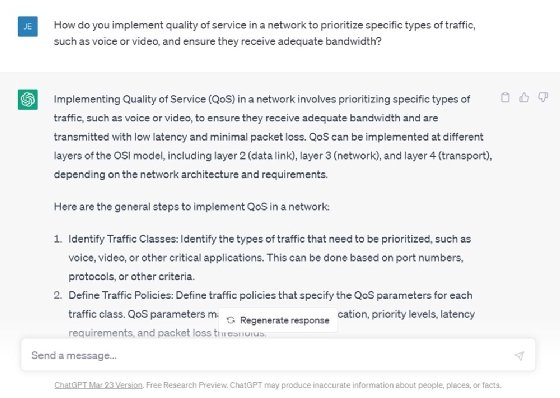
putilov_denis - stock.adobe.com
How ChatGPT can assist with network management
Network professionals can use ChatGPT as a tool to automate mundane processes, write code, design networks and perform other tasks related to network management.
Since its public release in November 2022, IT professionals have mused about how ChatGPT will affect -- or eliminate -- their jobs. However, generative AI technology can assist network pros with a variety of complex tasks and automate mundane processes. ChatGPT could be a boon, rather than a threat, to network teams.
ChatGPT can help with troubleshooting, improve network segmentation and architecture design, and increase network performance, said Alberto Roldan, founder and owner of Artificial Intelligence and Business Analytics Group. Network pros who aren't skilled in these areas can use AI as a valuable assistant.
Roldan, a strategic consultant in AI and independent tester of ChatGPT since its release, said he uses ChatGPT daily. For example, he tests ChatGPT's capabilities in AI, history and humanities and evaluates its weaknesses, challenges and strengths. So far, he said he likes what he sees.
ChatGPT's ability to automate network tasks
One benefit of ChatGPT is it gives network pros the ability to automate various tasks and processes. ChatGPT simplifies tasks and can provide code for many network automation requests in a near-instantaneous fashion.
According to Diego Lo Giudice, vice president and principal analyst at Forrester Research, network pros can instruct ChatGPT on which process they would like to automate. The chatbot searches the web for applicable code and then presents it in its exact and complete form.
Lo Giudice said network pros have the ability to use ChatGPT-provided code or combine it with their own code. Combining ChatGPT-generated code with native code can extend, modify and maintain the existing code. Further, network pros can choose between the code they want to write versus what they want to delegate to ChatGPT, and they have the ability to make changes as they go, Lo Giudice said.
Networking queries for ChatGPT
ChatGPT searches the internet to find all the information available on a specific networking topic. ChatGPT then condenses the information into a single format and provides a detailed yet simple-to-understand analysis with instructions.
Eric Wang, vice president of AI at educational software firm Turnitin, said ChatGPT instructions are easy to follow because the software looks for all documentation on a topic and identifies frequently used words to describe it.
ChatGPT then builds its instructions, one word at a time, using the most common word appropriate for each component of the sentence. Essentially, ChatGPT produces the most average description it can, Wang said.

According to Roldan, network pros can ask ChatGPT various questions and receive detailed and complete responses in return. Those prompts include the following:
- How do you implement quality of service (QoS) in a network to prioritize specific types of traffic, such as voice or video, and ensure they receive adequate bandwidth?
- How do you design a network architecture that can handle high availability and load balancing across multiple data centers or cloud environments?
- How do you troubleshoot a network issue that involves multiple layers of the OSI model, such as problems with DNS resolution that affect application performance?
- Can you explain the concept of network segmentation and how to use it to improve security and performance in large networks?
The drawbacks and future of ChatGPT for businesses
ChatGPT is still a new product with its share of limitations and challenges, Roldan said. However, OpenAI, the software manufacturer that develops ChatGPT, is already working on a new iteration of the software.
Roldan said ChatGPT isn't currently reliable to automate all network tasks. One drawback of ChatGPT is it blindly considers every piece of data it encounters as accurate and useful. ChatGPT needs more training to better distinguish the value of data it discovers. Once that happens, Roldan said, there is little with which the software won't be able to assist.
"In the future, I see an integration of nanotechnology and emotion recognition technology with generative AI that [will] greatly and autonomously improve networks, architectures and performance," he said.







